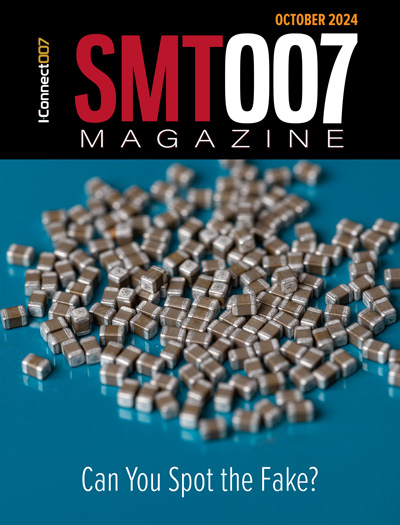-

- News
- Books
Featured Books
- smt007 Magazine
Latest Issues
Current Issue
The Rise of Data
Analytics is a given in this industry, but the threshold is changing. If you think you're too small to invest in analytics, you may need to reconsider. So how do you do analytics better? What are the new tools, and how do you get started?

Counterfeit Concerns
The distribution of counterfeit parts has become much more sophisticated in the past decade, and there's no reason to believe that trend is going to be stopping any time soon. What might crop up in the near future?

Solder Printing
In this issue, we turn a discerning eye to solder paste printing. As apertures shrink, and the requirement for multiple thicknesses of paste on the same board becomes more commonplace, consistently and accurately applying paste becomes ever more challenging.
- Articles
- Columns
Search Console
- Links
- Media kit
||| MENU - smt007 Magazine
Scientists Study the Insulator-Superconductor Transition of Copper-Oxide Compound in Fine Detail
April 11, 2016 | BNLEstimated reading time: 4 minutes
At a fixed low temperature, decreasing the doping level or increasing the applied magnetic field both suppressed superconductivity, allowing a competing state of electronic order to take over. Dramatic fluctuations appeared in the Hall resistance below a critical temperature, and these fluctuations increased in frequency and magnitude as all samples were further cooled toward absolute zero, indicating that they are of quantum origin.
"The behavior of these fluctuations is opposite to that seen in fluctuations driven by thermal energy, such as the vapor bubbles that appear when water is boiled," said Wu. "The bubbles fade away as the temperature is lowered."
The Hall resistivity measurements compared over the entire range of magnetic fields tested revealed that the samples have "memory" of their prior electronic states. After a magnetic field was applied, the value and sign of the Hall resistivity changed. When the magnetic field was removed, the samples stayed in the same electronic configuration until the field was reapplied—a very unusual property for conductors.
The scientists' data reveal that, at near-absolute-zero temperatures, the superconducting state competes with another state of electronic order characterized by the random distribution of many small charge "clusters," or localized groups of electrons. Unlike the free-flowing electrons in metals and superconductors, the electrons in these clusters are localized and pinned to particular atoms, rendering them immobile and unable to carry current when an electric field is applied. The clusters can hop around and trade places in the lattice as a result of quantum fluctuations.
"This picture explains the weak conductivity of this strange "insulating" state, revealing that the state originates from localization of charges," said Wu. "Our conclusion builds upon our understanding of the insulator-superconductor transition in an important class of high-temperature superconductors. We are one step closer toward our goal of predicting and designing new superconducting materials with superior properties for energy applications."
This research was funded by the Office of Science within the U.S. Department of Energy. Other authors include Anthony Bollinger of Brookhaven Lab and Yujie Sun of Brookhaven Lab and the Chinese Academy of Sciences.
Page 2 of 2Suggested Items
Unlocking Advanced Circuitry Through Liquid Metal Ink
10/31/2024 | I-Connect007 Editorial TeamPCB UHDI technologist John Johnson of American Standard Circuits discusses the evolving landscape of electronics manufacturing and the critical role of innovation, specifically liquid metal ink technology, as an alternate process to traditional metallization in PCB fabrication to achieve ever finer features and tighter tolerances. The discussion highlights the benefits of reliability, efficiency, and yields as a tradeoff to any increased cost to run the process. As this technology becomes better understood and accepted, even sought out by customers and designers, John says there is a move toward mainstream incorporation.
Fresh PCB Concepts: The Critical Nature of Copper Thickness on PCBs
10/31/2024 | Team NCAB -- Column: Fresh PCB ConceptsPCBs are the backbone of modern electronics and the copper layers within these boards serve as the primary pathways for electrical signals. When designing and manufacturing PCBs, copper thickness is one of the most critical factors and significantly affects the board’s performance and durability. The IPC-6012F specification, the industry standard for the performance and qualification of rigid PCBs, sets clear guidelines on copper thickness to ensure reliability in different environments and applications.
Book Excerpt: The Printed Circuit Designer’s Guide to... DFM Essentials, Ch. 1
10/25/2024 | I-Connect007The guidelines offered in this book are based on both ASC recommendations and IPC standards with the understanding that some may require adjustment based on the material set, fabricator processes, and other design constraints. This chapter details high-frequency materials, copper foil types, metal core PCBs, and the benefits of embedded capacitance and resistor materials in multilayer PCBs.
The Cost-Benefit Analysis of Direct Metallization
10/21/2024 | Carmichael Gugliotti, MacDermid AlphaCarmichael Gugliotti of MacDermid Alpha discusses the innovative realm of direct metallization technology, its numerous applications, and significant advantages over traditional processes. Carmichael offers an in-depth look at how direct metallization, through developments such as Blackhole and Shadow, is revolutionizing PCB manufacturing by enhancing efficiency, sustainability, and cost-effectiveness. From its origins in the 1980s to its application in cutting-edge, high-density interconnects and its pivotal role in sustainability, this discussion sheds light on how direct metallization shapes the future of PCB manufacturing across various industries, including automotive, consumer electronics, and beyond.
Connect the Dots: Designing for Reality—Pattern Plating
10/16/2024 | Matt Stevenson -- Column: Connect the DotsIn the previous episode of I-Connect007’s On the Line with… podcast, we painted the picture of the outer layer imaging process. Now we are ready for pattern plating, where fabrication can get tricky. The board is now ready to receive the copper traces, pads, and other elements specified in the original CAD design. This article will lay out the pattern plating process and discuss constraints in the chemistries that must be properly managed to meet the customer's exacting manufacturing tolerances.


